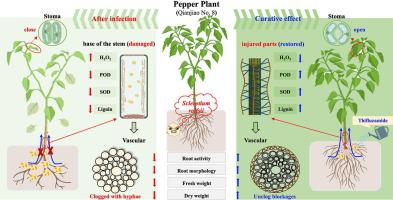当前位置:
X-MOL 学术
›
Pestic. Biochem. Phys.
›
论文详情
Our official English website, www.x-mol.net, welcomes your feedback! (Note: you will need to create a separate account there.)
Application of thifluzamide to stem rot in peppers: Infection and control mechanisms of sclerotium rolfsii
Pesticide Biochemistry and Physiology ( IF 4.7 ) Pub Date : 2024-03-02 , DOI: 10.1016/j.pestbp.2024.105846 Dandan Song , Rong Wen , Kuai Chen , Fanglin Wen , Dan Xing , Zhibing Wu
Pesticide Biochemistry and Physiology ( IF 4.7 ) Pub Date : 2024-03-02 , DOI: 10.1016/j.pestbp.2024.105846 Dandan Song , Rong Wen , Kuai Chen , Fanglin Wen , Dan Xing , Zhibing Wu

|
In recent years, the fungal disease ‘pepper stem rot’, contracted from the soil-borne pathogen has been increasing year by year, causing significant losses to the pepper ( L.) industry. To investigate the infection mechanism of stem rot, the fungus was used to infect the roots of pepper plants, and was found to affect root morphology and reduce root activity, which subsequently inhibited root growth and development. With fungal infestation, its secretions (oxalic acid, PG and PMG enzyme) were able to break normal tissues in the stem base and induced the burst of the active oxygen, which leads to injury aggravation. Morphological observations of the site of damage at the base of the stem using SEM revealed that the vascular bundles and stomata were completely blocked by hyphae, resulting in a blockade of material exchange in the plant. It was subsequently found that most of the stomata in the leaves were closed, which caused the leaves to lose their ability to photosynthesize, then turned yellow, wilt, shed, and the plant died. Commercialized fungicide thifluzamide with excellent (EC = 0.1 μg/mL) and curative (EC = 29.2 μg/mL) antifungal activity was selected to control the stem rot disease in peppers. The results demonstrated that it was able to suppress the secretion of associated pathogenic factors and reduce the outbursts of reactive oxygen species, thus reducing the damage caused by at the base of the plant's stem and also enhancing the root activity of the infected plant, thereby promoting root growth. It could also inhibit fungal growth, unblock the vascular bundles and stomata, maintain a balance of material and energy exchange within the plant, and thus restore the damaged plant to its normal growth capacity. All the results will provide an adequate reference for the prevention and control of stem rot disease on peppers with thifluzamide.
中文翻译:

噻氟酰胺在辣椒茎腐病中的应用:罗氏菌核的侵染及防治机制
近年来,由土传病原菌引起的真菌病害“辣椒茎腐病”逐年增多,给辣椒产业造成重大损失。为了研究茎腐病的感染机制,利用该真菌感染辣椒植物的根部,发现该真菌影响根部形态并降低根部活力,从而抑制根部生长和发育。真菌侵染时,其分泌物(草酸、PG、PMG酶)能破坏茎基部正常组织,诱发活性氧爆发,导致损伤加重。利用扫描电镜对茎基部受损部位进行形态学观察,发现维管束和气孔完全被菌丝堵塞,导致植物体内物质交换受阻。随后发现,叶片中大部分气孔关闭,导致叶片失去光合作用能力,进而变黄、枯萎、脱落,植株死亡。选择具有优异(EC = 0.1 μg/mL)和治疗性(EC = 29.2 μg/mL)抗真菌活性的商品化杀菌剂噻氟酰胺来防治辣椒茎腐病。结果表明,它能够抑制相关病原因子的分泌,减少活性氧的爆发,从而减轻植物茎基部的损伤,同时增强受感染植物的根系活力,从而促进病害的发生。根生长。它还可以抑制真菌生长,疏通维管束和气孔,维持植物体内物质和能量交换的平衡,从而使受损植物恢复正常生长能力。研究结果将为噻氟酰胺防治辣椒茎腐病提供充分的参考。
更新日期:2024-03-02
中文翻译:

噻氟酰胺在辣椒茎腐病中的应用:罗氏菌核的侵染及防治机制
近年来,由土传病原菌引起的真菌病害“辣椒茎腐病”逐年增多,给辣椒产业造成重大损失。为了研究茎腐病的感染机制,利用该真菌感染辣椒植物的根部,发现该真菌影响根部形态并降低根部活力,从而抑制根部生长和发育。真菌侵染时,其分泌物(草酸、PG、PMG酶)能破坏茎基部正常组织,诱发活性氧爆发,导致损伤加重。利用扫描电镜对茎基部受损部位进行形态学观察,发现维管束和气孔完全被菌丝堵塞,导致植物体内物质交换受阻。随后发现,叶片中大部分气孔关闭,导致叶片失去光合作用能力,进而变黄、枯萎、脱落,植株死亡。选择具有优异(EC = 0.1 μg/mL)和治疗性(EC = 29.2 μg/mL)抗真菌活性的商品化杀菌剂噻氟酰胺来防治辣椒茎腐病。结果表明,它能够抑制相关病原因子的分泌,减少活性氧的爆发,从而减轻植物茎基部的损伤,同时增强受感染植物的根系活力,从而促进病害的发生。根生长。它还可以抑制真菌生长,疏通维管束和气孔,维持植物体内物质和能量交换的平衡,从而使受损植物恢复正常生长能力。研究结果将为噻氟酰胺防治辣椒茎腐病提供充分的参考。



























 京公网安备 11010802027423号
京公网安备 11010802027423号